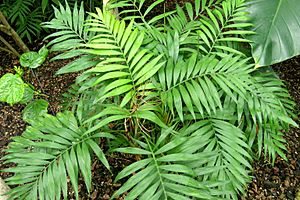Neanthe bella palm facts for kids
Quick facts for kids Neanthe bella palm |
|
|---|---|
 |
|
| C. elegans (parlour palm) in Berlin | |
| Scientific classification | |
| Genus: |
Chamaedorea
|
| Species: |
elegans
|
| Subspecies | |
|
|
| Synonyms | |
|
|
The Chamaedorea elegans, also known as the neanthe bella palm or parlour palm, is a small palm tree. It originally comes from the rainforests of Southern Mexico and Guatemala. This palm is super popular! It's one of the most common houseplants sold around the world. Its leaves are also harvested for something called xate, which is used in flower arrangements.
This plant is so well-loved that it has won the Royal Horticultural Society's Award of Garden Merit. This award means it's an excellent plant for gardens.
Contents
What the Parlour Palm Looks Like
The parlour palm is a woody plant with a thin, green trunk. It grows in tropical areas and can reach about 2 to 3 meters (6.5 to 10 feet) tall. Sometimes, it can even grow up to 4 or 5 meters (13 to 16 feet)!
Its stems are flexible and don't have any sharp spines. The leaves are usually pinnate, which means they look like feathers with many small leaflets. A mature plant can have 3 to 10 long, feathery leaves at the top.
One cool thing about this palm is that it starts flowering very early. Some plants can bloom when they are only about 30 centimeters (12 inches) tall!
Flowers and Berries
The parlour palm has small flowers that can be light yellow, yellow, or orange-red. They have a nice smell. These flowers grow in clusters below or among the leaves. They look like tiny balls without petals, a bit like mimosa flowers.
Sometimes, after the flowers bloom, small, dark berries appear. These berries are about 6 millimeters (0.24 inches) wide, like small peas. They grow in bunches.
How to Grow a Parlour Palm
The parlour palm is often grown as a houseplant in places with mild weather. In warmer areas, like the Southeastern United States, it can grow in gardens. It grows slowly, usually reaching about 2 meters (6.5 feet) tall.
When you buy a parlour palm, it's often sold as a group of 5 to 30 small plants. Over time, some of these plants will grow stronger and taller. The weaker ones might not get enough light and will eventually die. This leaves a few strong plants that can live for many decades in a pot.
This palm can handle low humidity and not much light. However, it prefers medium to high humidity and bright, indirect light. It doesn't like frost at all. So, if you live in a cold place, you must keep it indoors during winter.
Caring for Your Palm
The parlour palm likes light potting soil. It also enjoys good humidity and moderate light, but not direct sunlight. It can even handle some dry conditions or less light. In winter, it's best if the room temperature stays around 12-14 degrees Celsius (54-57 degrees Fahrenheit).
This plant was very popular during the Victorian era. This was because it could survive in the often dark and unheated homes in Britain back then. It also thrived in greenhouses, where people grew exotic plants as a hobby.
You can only grow new parlour palms from sowing seeds.
In Nature
In its natural rainforest floor home, the parlour palm often competes with climbing vines. It can sometimes be seen growing along rock walls, which helps support its thin stem. Because its stem is thin, the palm might fall over during storms if it grows in an open area. However, older plants can sometimes re-root from their rhizomes if they have grown new roots higher up the stem.
Different Types of Parlour Palms
Scientists believe there are at least two types of Chamaedorea elegans that grow naturally. One type has a thinner stem and grows in lower areas. The other type, found in higher places, tends to have a thicker stem.
There are also a few special types grown by people, like one with "dark leaves." But these are rare. Most of the parlour palms you see in stores are the standard bright green kind.
Where Parlour Palms Grow Wild
In the wild, you can find the parlour palm in Belize, the Gulf of Mexico, and several states in Mexico. These Mexican states include Chiapas, Campeche, Guerrero, Hidalgo, Oaxaca, Puebla, Quintana Roo, San Luis Potosí, Tabasco, Veracruz and Yucatan.
In Guatemala, it grows in Huehuetenango, Alta Verapaz, and Petén Department.
Gallery
See also
 In Spanish: Chamaedorea elegans para niños
In Spanish: Chamaedorea elegans para niños






